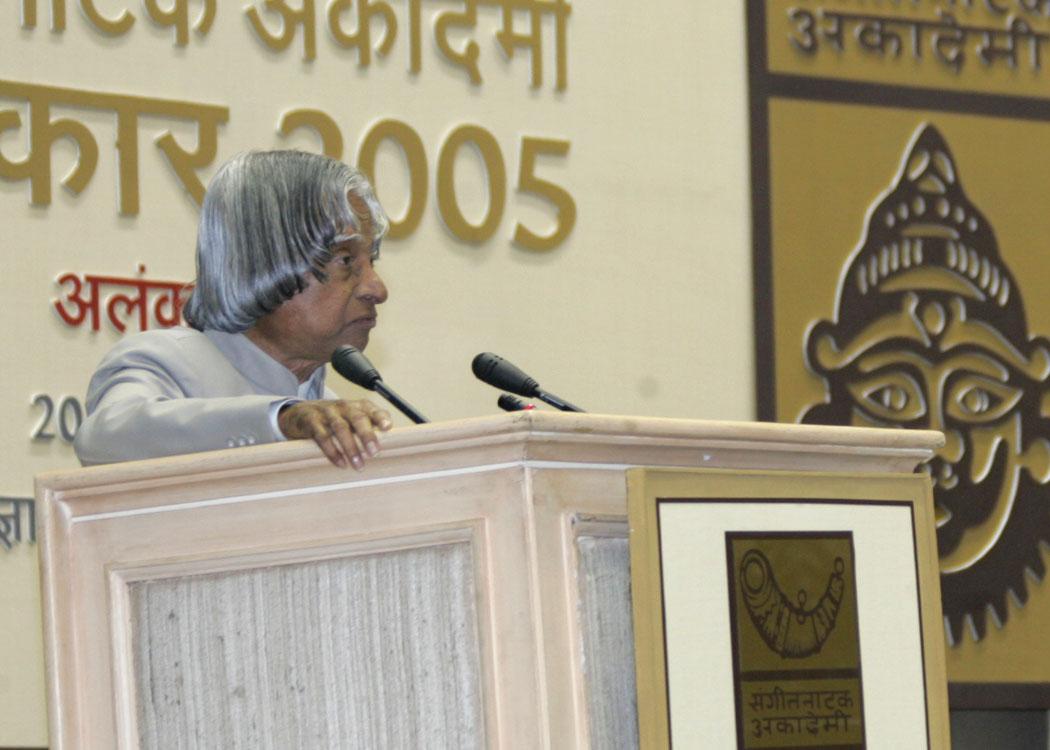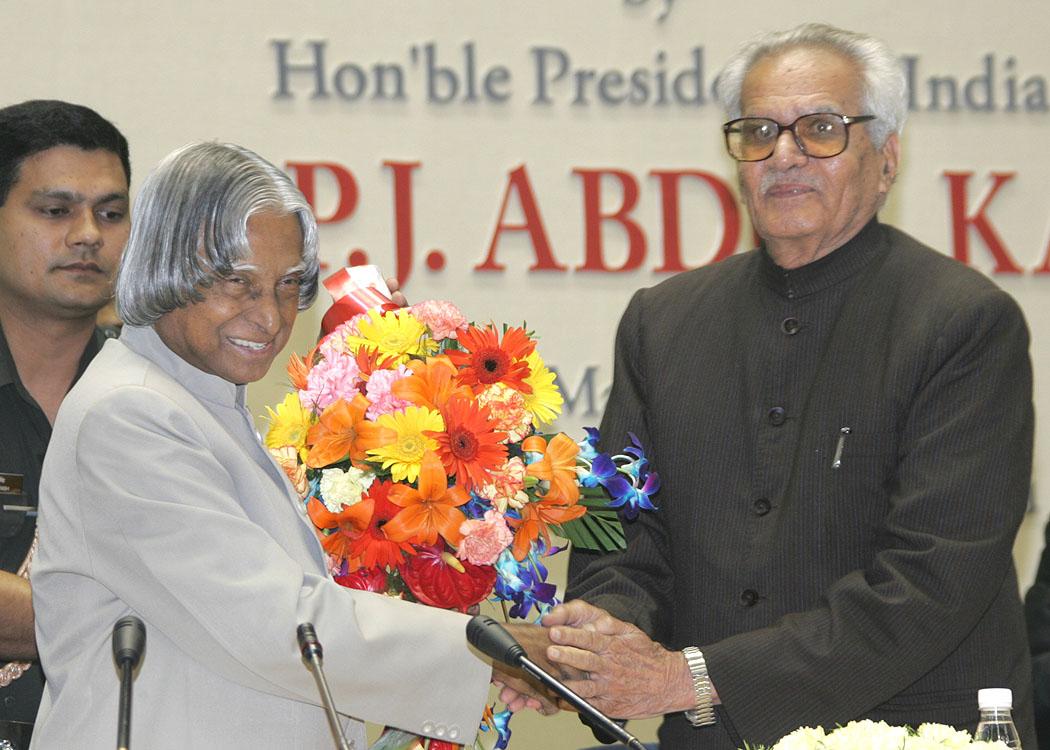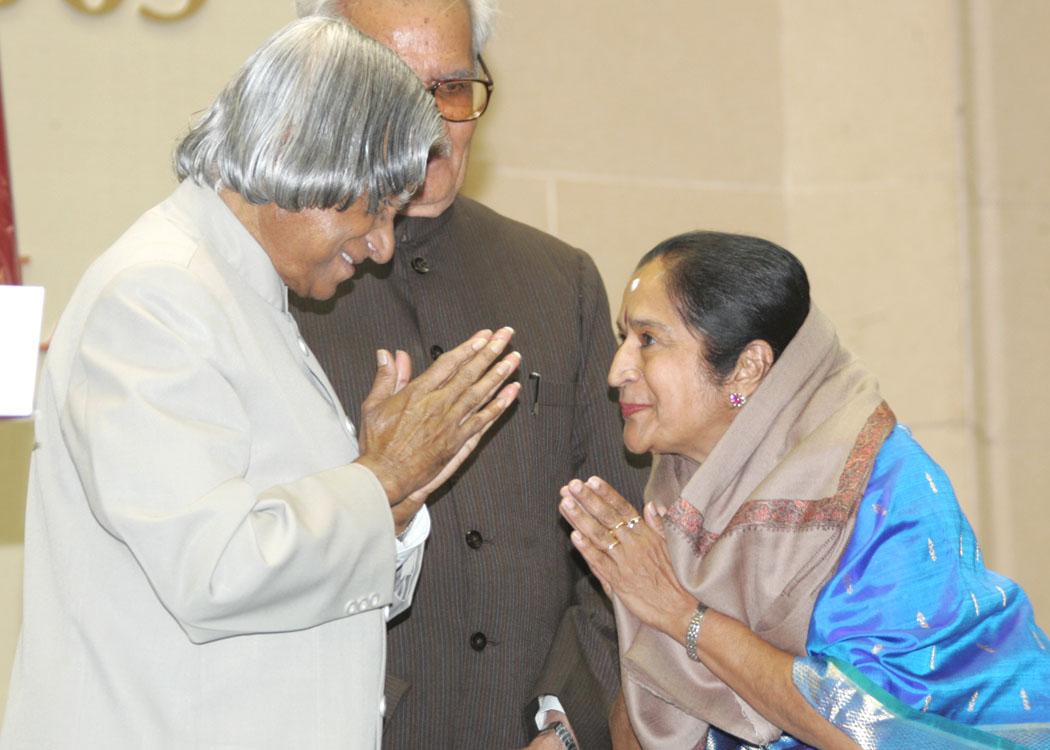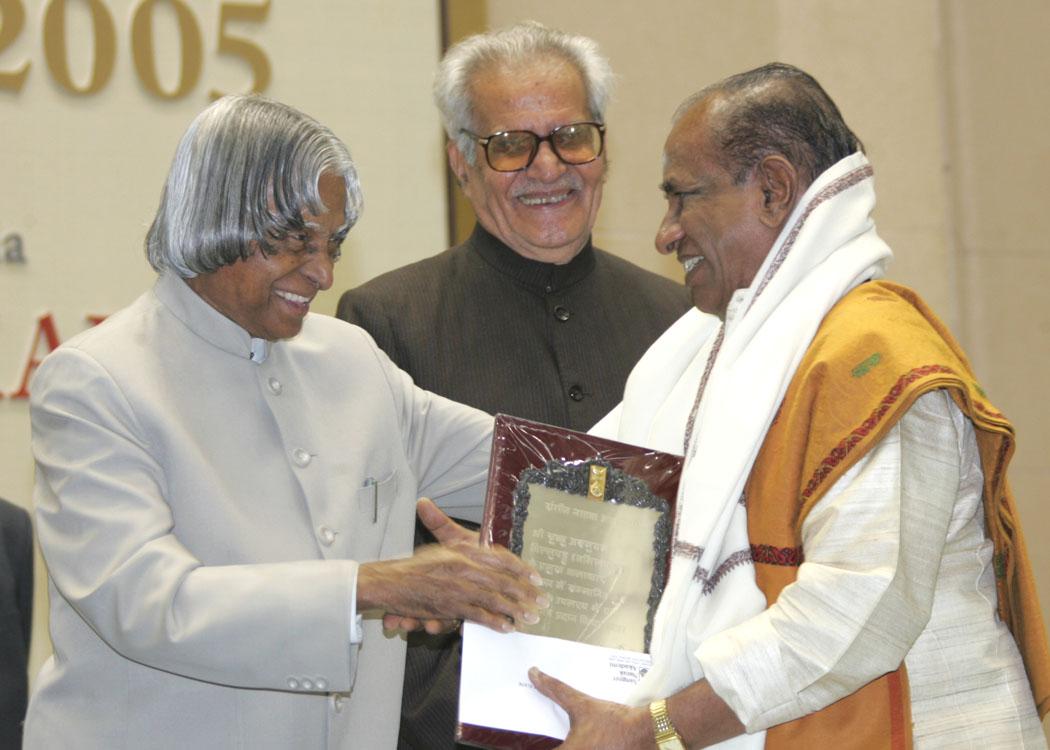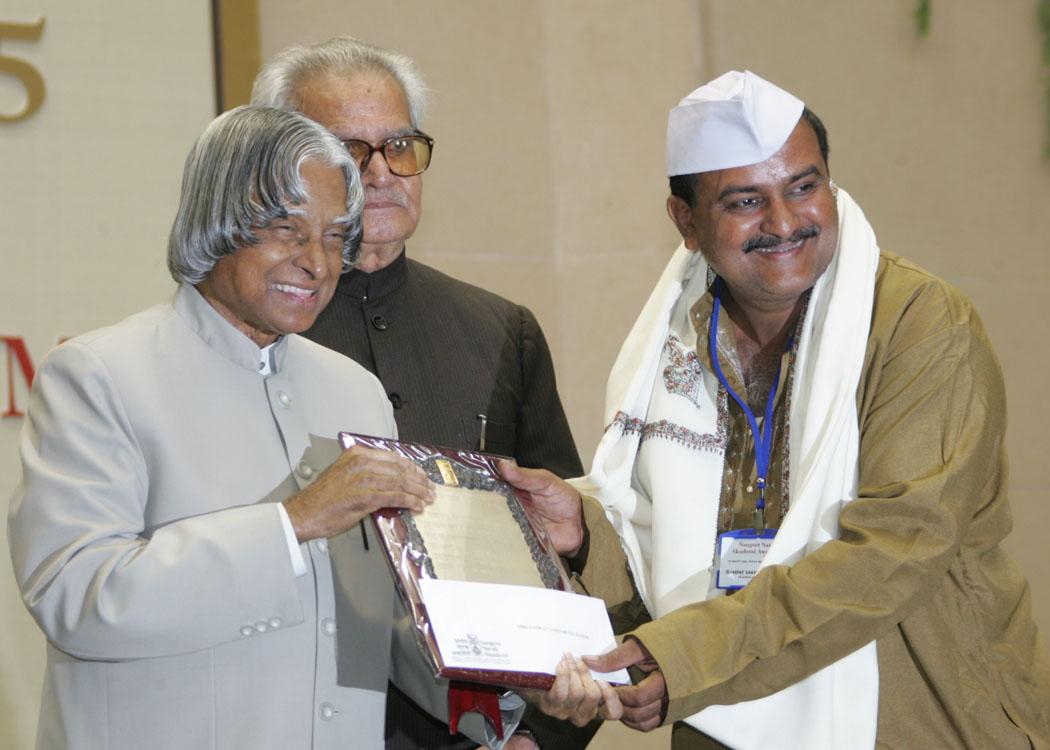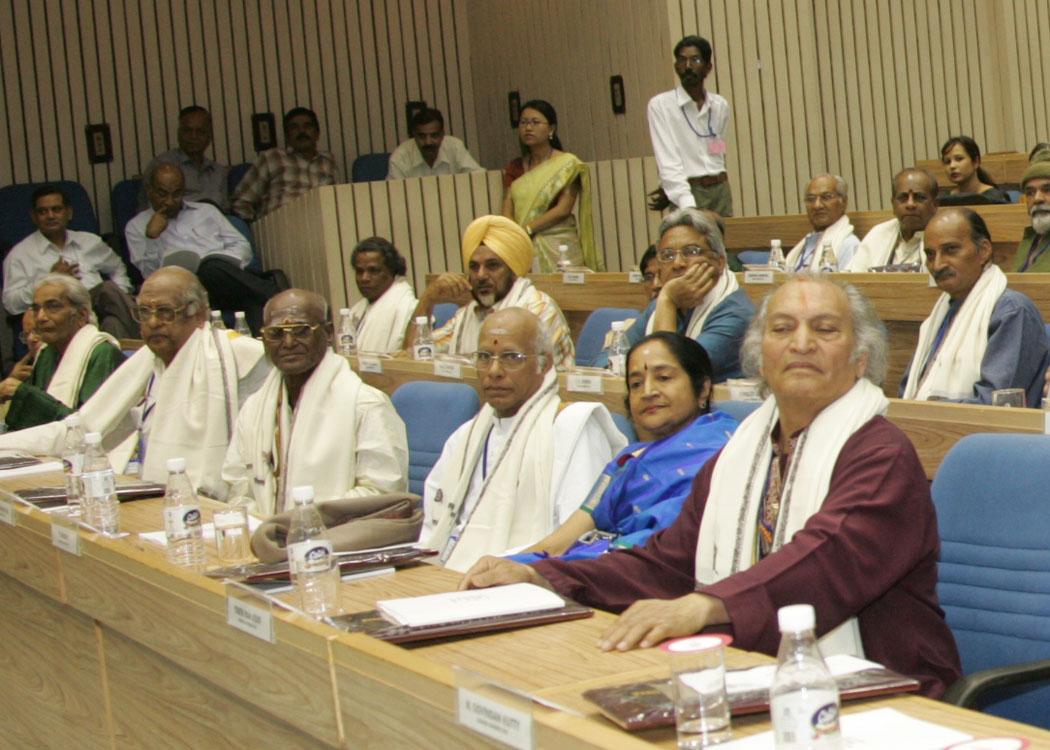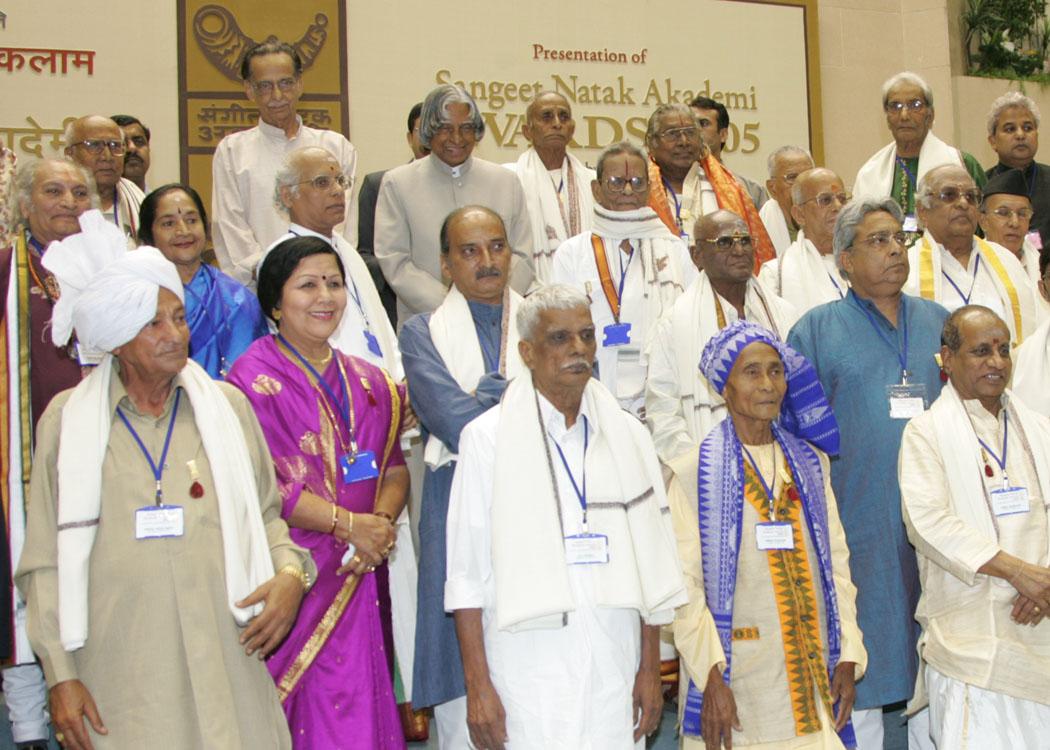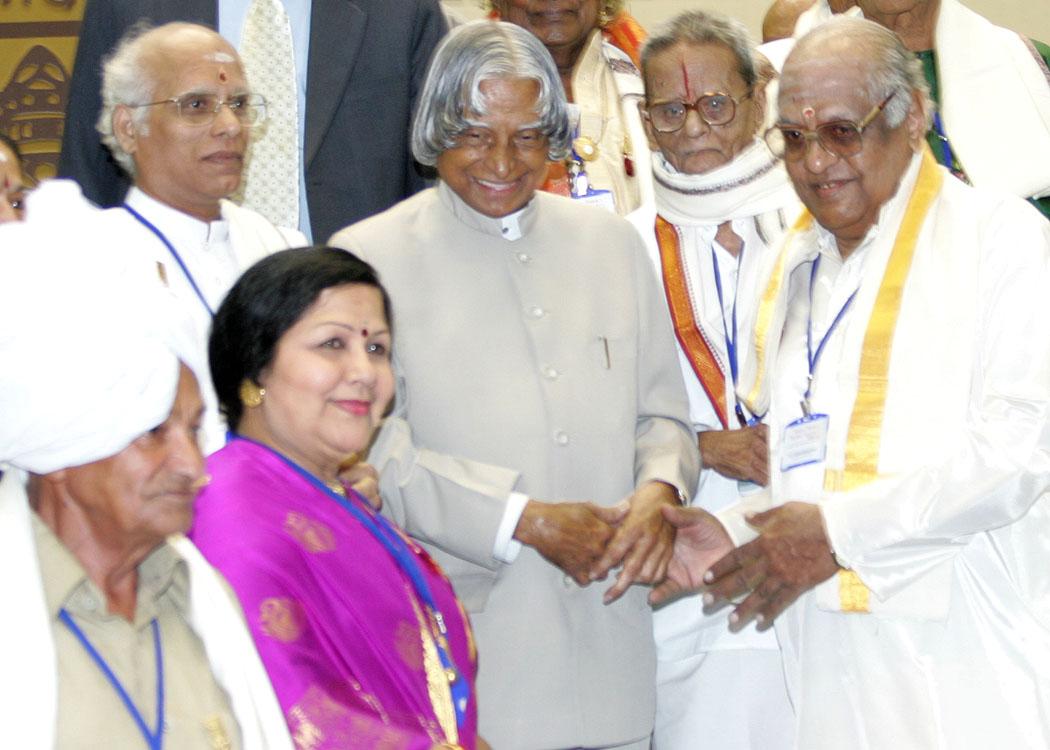Address At The Conferment Of Sangeet Natak Akedemy Awards For The Year 2005, New Delhi
New Delhi : 20-03-2006
Music Blossoms Happiness
I am delighted to participate in the Sangeet Natak Akademi Awards for the year 2005. My greetings to the organizers, dancers, theatre artists, musicians and all other distinguished participants. The 54 year old Sangeet Natak Akademi has done a commendable job in recognizing and honouring artists, giving them their rightful place in the field of performing art. While doing so, it has preserved and promoted the performing art culture of India. I extend my congratulations to all the deserving performing artists who are going to receive the Sangeet Natak Akademi Award for the year 2005.
Music has Universal Appeal
Music elevates the mind, its appeal is universal and from ages its impact on human behaviour has been perceptible. Just the other day I was reading a publication on ?Music Perception, Cognition and Behaviour? by Norman Weinberger and I was surprised to learn that all over the world the impact of music on human behaviour is being studied with so much of interest. The study also indicated how music can promote physiological and behavioural relaxation hence is being used in many hospitals as a positive treatment therapy. Music touches the heart and mind and evolves good human beings and society. Music indeed reinforces creativity and talents of personnel.
Music with a Social Responsibility
Our country has talented artists and today I am happy to be in the midst of those who have rendered sustained, meritorious service and have given happiness to the hearts of our people and the nation. I am fully convinced that art, music, dance, drama gives connectivity to the multiple variants in the society. Music can reduce the mental pressures and heaviness in the heart. Can I request all, the great musicians, theater artists, dancers who are present here today that you will take upon yourselves a mission ? a mission of using your performing art for achieving the unity of minds. I am fully convinced that if this happens, the disturbing acts like conflicts and terrorism, etc. could be reduced. May be one day all of you present here will become successful in forming a peace teams of performing artists who will offer an alternative solution to the military and judicial approach normally applied to the problems like terrorism etc.
Performing Art has no Boundaries
Whenever I visit any State in India or when I go on trips to foreign countries, be it South Africa, Korea, Philippines, Myanmar, Mauritius, I have been noticing that wherever there is music, wherever there is dance, there is no need for any language. We need not follow the exact word; it is simply the rhythm that captivates. The communication is set up automatically and the barriers are broken. I was very happy to see in Singapore that during a performance in ?Singapore India Fine Arts Society? many teams from multiple races also performed Bharatnatyam along with our own children. In spite of having different mother tongues; they were all speaking the same language of dance and music, which united them so easily and seamlessly.
Nurturing the Performing Art
With the advent of the electronic media and its strong hold on the masses, the performing arts have to penetrate through competitive performance. When I was in School, we used to look forward to dramas being enacted in Schools and even outside and through them I can recollect many of our traditional folklores which have got embedded in my mind. Our artists and musicians should make special efforts to encourage the young minds to participate in innovative classical presentation. I recently inaugurated a musical programme Parampara ? the generation next? ? which was a seminar on endangered musical instruments organized by the Madhumurchana, I felt it was a great service being done by the organization to the Indian Culture by preserving and promoting unique art forms. I understand similar efforts are being made by the Sangeet Natak Akademi in preserving the art forms which are traditional. I would ask all of you who are in this field to take upon themselves the responsibility of promoting and nurturing their art forms so as to achieve a sustainable growth in the field of performing art forms.
Performing Art and Rashtrapati Bhavan
The Mughal Gardens in Rashtrapati Bhavan with all their flora are a treat to the human mind but its beauty doubles whenever a cultural programme is organized in the Central Lawns. We organized a Violin and vocal recital by Dr. L. Subramaniam, a Flute recital by Pt. Hari Prasad Chaurasia and very recently we had a jugalbandi between Ustaad Bismillah Khan and Dr. Soma Ghosh, a vocalist. On these occasions, I felt that the Gardens looked beautiful under the spell of music. To ensure that the magic of music continues to be there in the Gardens on all days, a Musical Fountain has recently been added to the Mughal Gardens, where the fountains dance to the tune of Ustaad Bismillah Khan?s shehnai, Pt. Shiv Kumar Sharma?s Santoor, the music of A. R. Rehman and Shri Duraisamy Iyengar?s Veena. I really believe that without music, dance and theatre the world would not be the same.
Encouraging Young Artists
On one hand, there is a decline in the interest of the younger generation towards classical art forms. On the other hand, many young artists from all over the country, especially from small villages and towns, who in spite of the interest in art are finding it difficult to enter and pursue the performing art forms? I understand that there are many entry barriers, which they are faced with. I think I am in the right forum today and so I urge all the artists present and the Sangeet Natak Akademi to encourage the young and budding artists and get them early recognition, so that they can enter into the rich art culture of our country which indeed needs nourishment in the form of young performers.
Exclusive Television channel for Indian Classical Music
To enable the younger generation to listen to music from endangered musical instruments, I would suggest that the electronic media can record the musical programme of legendary personalities who have played instruments like Sarod, Jalatarang, Rudra Veena etc. These recorded music can be played in the TV channels at the prime time on specified days in a week, so that the younger generation can hear and get interested in the particular instrument through repeated listening. This will be a great service done by the electronic media for preservation music played by unique instruments. Both DD and Private Channels can participate in such programmes. As a next step music lovers and artists can also think in terms of creating a dedicated channel for classical music in multiple languages.
Sponsoring by Organizations
Today organizations are making sports personalities their brand ambassadors. In the similar fashion, great musicians who have performed programmes using unique instruments like vichitra veena, surbahar, santoor, tabla tarang can be sponsored as brand Ambassadors by organizations. Such sponsorships will enable the musicians to undertake training of youngsters who have an aptitude to learn a particular instrument even though they may not have adequate finances to take it up as a hobby. The sponsorship will also help to create certain amount of scholarships to musically inclined students as a full time professional training activity.
Modernization through research
I understand that Baluswami Dikshithar, brother of one of the trinity of carnatic music Muthuswamy Dikshithar, is the pioneer, who brought violin into the fold of Carnatic music and fused it into Indian classical music system. It showed the breadth of vision and elasticity of our traditions arts to surpass time and absorb the best of times. Chowdaiah continued this great tradition and made a unique contribution to violin through his seven string violin which has been carried out through intense research. Similarly, Ustad Bismillah Khan has the ability to produce intricate sound patterns on the shehnai which before his time, were considered impossible on this instrument. He has been a source of inspiration to succeeding generations of shehnai players and has groomed many in this fine art. Pandit Shivkumar Sharma's father was the first to realize the potential of the Santoor as a viable classical instrument. He did considerable research on it. As he started learning the instrument, Pandit Shivkumar Sharma took it upon himself to fulfill his father's wishes and bring the instrument to the classical arena. To achieve this goal, he made innovations in the form and technique of Santoor. The instrument that Pandit Shivkumar Sharma had 25 bridges, with 4 strings each. He increased the number of bridges to 29 and reduced the number of strings to 3 per bridge, a total of 87. This brought greater clarity and took less time to tune. Ustad Zia Mohiuddin Dagar introduced important changes to Rudra Veena. I had heard Rudra Veena being played by Ustad Asad Ali Khan in the Rashtrapati Bhawan who is probably, one of the last known musicians playing this instrument. Like Rukmini Devi Arundale gave life to Bharatanatyam all the legendary Maestros whom I have described have given life to the instruments of their liking. The legendary personalities of classical Indian music assembled here can carry out research in their areas of specialization to improve the quality of the instrument which will bring deeper interest in a particular instrument by the younger generation.
Conclusion
Whenever I think about one billion people of our country and how to connect them, one thing always come to my mind. Our civilization has given us certain unique binding and integrating factors like the performing arts. The various dance forms, the Hindustani and Carnatic classical music and various theatre art forms are great integrators.
Recently when I was in Bangalore for the Silver Jubilee Celebrations of the Art of Living Foundation, I had a beautiful musical experience. In that gathering of over two million people 3,800 musicians played Saint Thyagaraja?s Kriti `Endaro mahanubhavulu... andariki vandanamulu using variety of instruments from veenas to nagaswarams, flutes, violins, saxophones, morsinghs and thavils for over fifteen minutes. How all the instruments were synchronized? I saw music becoming angelic. Such is the power of music to unify the minds of people.
I once again congratulate the recipients of Sangeet Natak Akademi Awards. My best wishes to all the members of the Sangeet Natak Akademi and hope that they are successful in preserving, nurturing and promoting the traditional art forms of our nation.
May God bless you.

